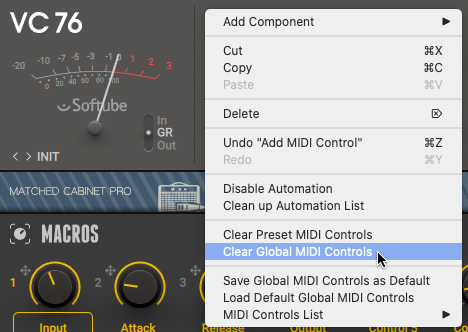Automation and MIDI Control
Guitar Rig can be controlled externally using automation in the DAW and MIDI controllers, and features full integration with Komplete Kontrol and Maschine using NKS.
Guitar Rig can be controlled externally using automation in the DAW and MIDI controllers. Streamlined functionality for managing automation IDs and MIDI assignments allows you to configure external control according to your needs. Guitar Rig is also fully integrated with Komplete Kontrol and Maschine, using NKS (Native Kontrol Standard) to automatically map parameters to the hardware controls.
Automation
Automation is used to control parameters in Guitar Rig from the DAW, for example by recording or drawing automation data in the DAW's timeline. The corresponding parameters read the automation data during playback and are adjusted automatically. You can use this to level out the sound according to changes in your recording, or for creative sound design by animating key parameters in real time.
Automation IDs
The Guitar Rig plug-in facilitates automation of parameters by using a combination of fixed and dynamically mapped automation IDs in the automation list reported to the DAW. Fixed automation IDs are always mapped to the same parameters, for example Macros. They are independent of the Rack content and the preset, meaning your automation will still function correctly even if you change the Rack or load a new preset. Dynamically mapped automation IDs are used for parameters of individual Components in the Rack. Since they automatically adapt to changes in the Rack, these automation IDs are specific to each individual preset and the current state of the Rack.
Note
When a parameter is assigned to a Macro control, it ignores automation data received on its own automation ID in order to prevent conflicting parameter changes.
The automation IDs in the automation list are grouped according to the function of the respective parameters, and whether their mapping is fixed or dynamic:
Automation ID 1-16: Fixed mapping to the Macro controls 1-16.
Automation ID 17-256: Dynamic mapping to the parameters of Components in the Rack.
Automation ID 257-276: Fixed mapping to the parameters in the Header.
Automation ID 277-384: Fixed mapping to the parameters of the Rack Tools.
Automation ID [385-512]: Dynamic mapping to the parameters of Components in the Global FX.
You can look up the automation ID of a specific parameter in the Rack by using the context menu.
Right-click a parameter to show its automation ID in the context menu.
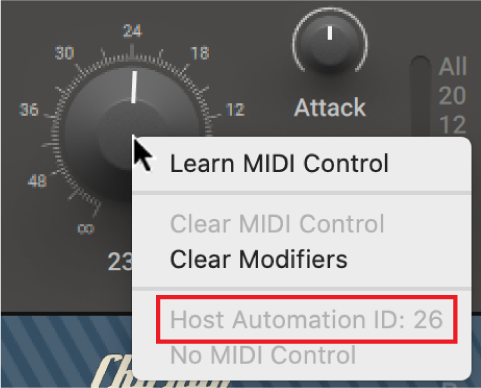
Deactivating Automation for Components
You can deactivate automation for individual Components in the Rack. When automation is deactivated for a Component, all of its parameters are removed from the automation list reported to the DAW and stop responding to incoming automation data.
To deactivate automation for a Component, right-click the Component and select Disable Automation from the context menu.
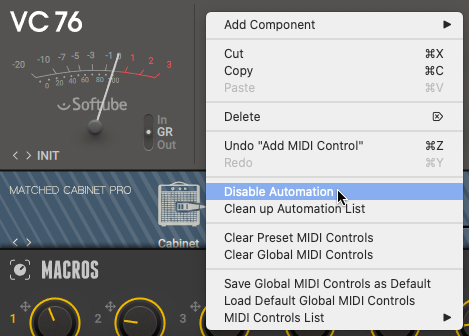
Note
You can use this function before cleaning up the automation list in order to reduce the amount of automation IDs and focus on the parameters you require in your project. For more information, refer to Cleaning up the Automation List.
Cleaning up the Automation List
You can consolidate all dynamically mapped automation IDs to clean up the automation list reported to the DAW. The corresponding function maps the automation IDs to the parameters in the Rack from top to bottom. The Macros, Header, and Rack Tools use fixed automation IDs for their parameters and therefore are not affected by this function.
To clean up the automation list, right-click the Component and select Clean up Automation List from the context menu.
Caution
This function maps new automation IDs to the parameters of Components in the Rack. If you have already automated these parameters in your project, the automation will not work correctly any more.
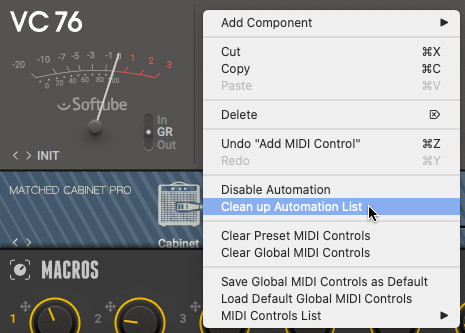
Note
You can deactivate automation for individual Components before cleaning up the automation list in order to reduce the amount of automation IDs and focus on the parameters you require in your project. For more information, refer to Deactivating Automation for Components.
MIDI Control
Parameters in Guitar Rig can be controlled using MIDI controllers, for example foot controllers and keyboards. Once a MIDI control is mapped to a parameter, you can use the hardware control to adjust the value of the parameter. This enables you to control the software intuitively and remotely, for example during a performance. Guitar Rig facilitates mapping of MIDI controls by providing MIDI learn and a streamlined set of functions to manage MIDI mappings directly in the Rack.
MIDI controls can be mapped to individual parameters of Components in the Rack. The mappings are stored in each individual preset. Additionally, MIDI controls can be mapped to global controls, for example preset selection and the Macros. In this case, mappings are stored globally, independently of the loaded preset. Global MIDI mappings are especially beneficial when using Macros. The MIDI mappings will function with any preset you load, and you can still assign the Macros to different parameters in each preset.
The following parameters use global MIDI mappings:
Preset selection in the Toolbar
Parameters of the Rack Tools including Macros
Parameters of Components in Global FX
The following parameters use individual MIDI mapping per preset:
Parameters of Components in the Rack
Parameters of Components in a Container
Tip
MIDI control via Macros enables you to set the exact range of a parameter you want to control. For more information, refer to Editing Macros.
Using MIDI Learn
You can map MIDI controls to parameters using MIDI learn. This function automatically recognizes incoming MIDI data, enabling you to create MIDI mappings simply by turning the hardware controls on your MIDI controller.
Note
Your MIDI controller needs to be activated in the Preferences. There you can also set the MIDI channel for receiving MIDI data. For more information, refer to MIDI.
To map a MIDI control to a parameter:
Right-click the parameter and select Learn MIDI Control in the context menu.
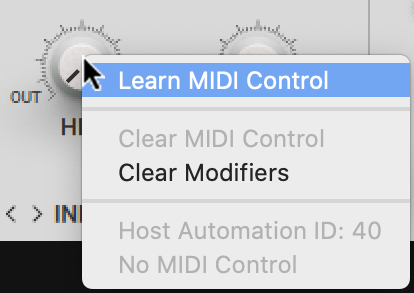
Activate the MIDI control you want to map by turning the knob, moving the fader, or pushing the button on your MIDI controller.
The MIDI control is mapped and can be used to adjust the parameter. The MIDI CC (Continuous Controller) number of the mapped MIDI control is shown in the parameter's context menu.
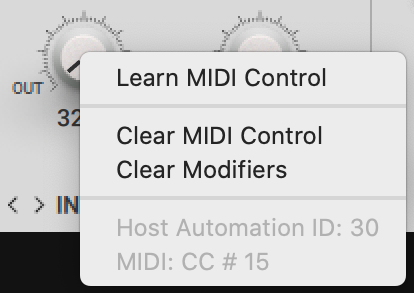
Managing MIDI Mappings
The Rack's context menu provides functions to manage MIDI mappings. You can view all MIDI mappings, save and load default global MIDI mappings, and clear MIDI mappings.
Viewing MIDI Mappings
You can view all existing MIDI mappings using the Rack's context menu.
To view all MIDI mappings, right-click on the background of a Component or the Rack and select MIDI Controls List in the context menu.
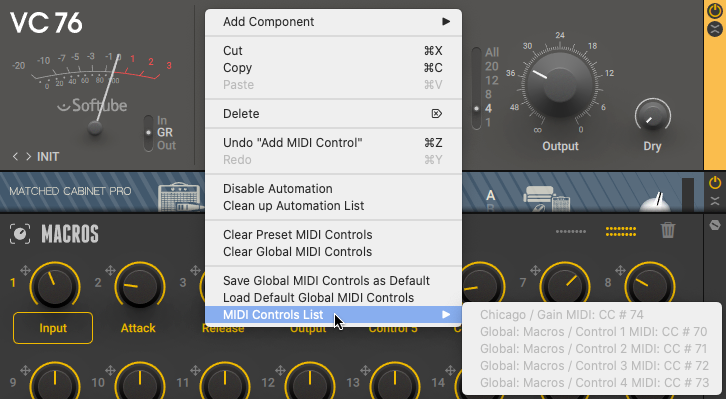
Saving Global MIDI Controls as Default
You can save the global MIDI mappings as default. This enables you to load them at any point and restore your standard MIDI controls that will work with any preset.
To save the global MIDI mappings as default, right-click on the background of a Component or the Rack and select Save Global MIDI Controls as Default in the context menu.
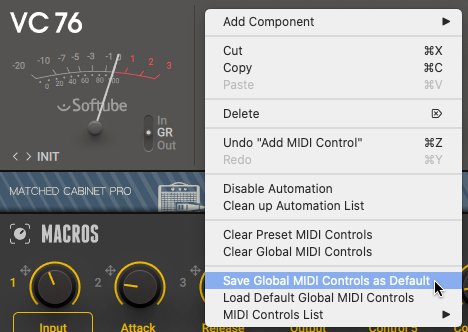
Loading the Default Global MIDI Controls
You can load global MIDI mappings that you have previously saved as default and thus restore your standard MIDI controls that will work with any preset.
To load the default global MIDI mappings, right-click on the background of a Component or the Rack and select Load Default Global MIDI Controls in the context menu.
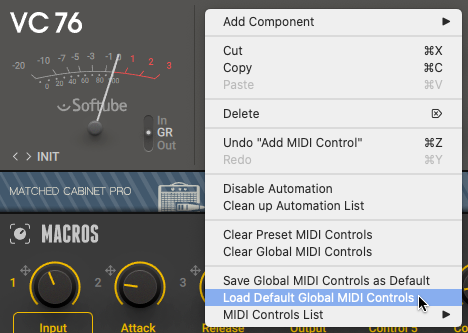
Clearing MIDI Controls
You can use a single command to clear either all individual MIDI mappings of a preset or all global MIDI mappings.
To clear the individual MIDI mappings of the preset, right-click on the background of a Component or the Rack and select Clear Preset MIDI Controls in the context menu.
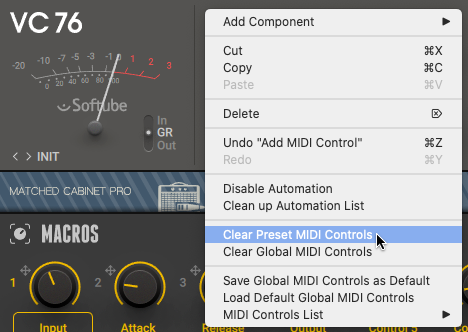
To clear the global MIDI mappings, right-click on the background of a Component or the Rack and select Clear Global MIDI Controls in the context menu.
